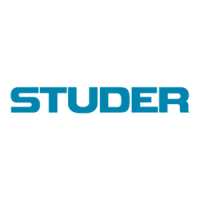
Do you have a question about the Studer A68 and is the answer not in the manual?
| THD | < 0.05% |
|---|---|
| Signal-to-Noise Ratio | > 100 dB |
| Total Harmonic Distortion | < 0.05% |
| Frequency Response | 20 Hz to 20 kHz |
| Power Output | 2 x 100 W into 8 Ohms |
Brief overview of the 40W power amplifier, its advantages, and applications.
Details on the 19" frame, power amplifier PCBs, and available options and accessories.
Detailed technical data including input impedance, frequency response, output power, and distortion.
Instructions for safely unpacking and checking the equipment for transport damage.
Guidelines for selecting a suitable installation location, considering dust, ventilation, and ambient temperature.
Description of the various connectors on the unit for input, output, and remote control.
Information on connecting the AC power and selecting the correct voltage for operation.
Details on the balanced line inputs and their XLR connectors.
Information on connecting loudspeakers via XLR or terminal strips, and minimum impedance.
Explanation of the 15-pin connector for remote control functions like muting or attenuation.
Instructions on how to set the gain and input level for optimal performance.
Procedures for safely replacing mains and amplifier fuses.
How to connect loudspeakers for standard two-channel operation.
Instructions for bridged operation, requiring a two-channel version and specific connections.
Safety precautions for handling sensitive MOS components to prevent static discharge.
Schematic diagram of the mains transformer connections.
Schematic diagram of the power amplifier sub-rack.
Schematic diagram of the power amplifier PCB.
Warning about dangerous voltages in the power supply and safe handling procedures.
List of spare parts with order numbers, descriptions, and quantities.